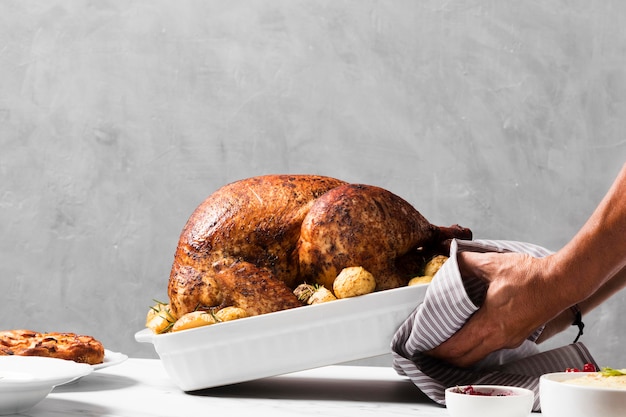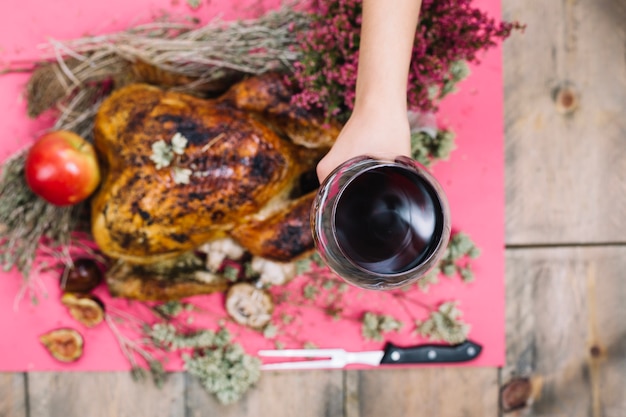It's that time of year again – the festive season is upon us, and the aroma of roasted turkey fills the air. A 14lb turkey is a hefty beast, and achieving a perfect roast can seem daunting, but trust me, it's absolutely doable. I've been tackling this bird for years, and I've learned a thing or two along the way. I'm here to guide you through my tried-and-tested method, transforming your kitchen into a haven of festive flavours.
(Part 1) The Preparation: Laying the Foundation

Before we even think about the oven, we need to prep our turkey. This stage is crucial for achieving that beautiful golden-brown skin and ensuring a perfectly cooked bird. Let's dive in!
Thawing: Patience is Key
First things first, we need to defrost our frozen turkey. The safest method is to thaw it out in the fridge. This takes time, about 24 hours for a 14lb turkey. So, planning is key! Make sure you have enough time for the turkey to completely thaw before you start cooking.
Washing and Drying: A Clean Slate
Once the turkey is thawed, give it a good wash inside and out, making sure to remove any excess moisture. Pat it dry with kitchen paper. This will help to prevent the skin from steaming and ensure a crisp, golden finish.
Seasoning and Stuffing: A Flavor Symphony
Now comes the fun part: seasoning! I’m a big fan of a classic butter-and-herb rub. Soften unsalted butter to room temperature and mix in fresh herbs like rosemary, thyme, and sage. Add a touch of black pepper for a subtle kick. Then, rub this mixture generously all over the turkey, both inside and out. The butter helps to create a beautiful, golden-brown crust, and the herbs infuse the meat with incredible flavour. This simple seasoning elevates the turkey to another level.
Now, let's talk stuffing. While I love a good stuffing, I prefer to stuff the turkey loosely to ensure even cooking. I typically use a classic sausage meat stuffing, but feel free to experiment! Add your favourite ingredients – onions, herbs, cranberries – but remember, the stuffing needs to be cooked through.
(Part 2) The Roast: Bringing the Magic to Life

The moment we've all been waiting for – the roasting! Get your biggest roasting tin ready, one that can comfortably hold the turkey without it being squashed. It's time to bring out the culinary magic.
Vegetable Base: A Feast of Flavors
Before we place the turkey in the tin, I like to add a layer of vegetables. Carrots, onions, and potatoes are perfect choices. They will not only add flavour to the turkey juices but also become a delicious side dish later.
Temperature: Finding the Sweet Spot
Preheat your oven to 325°F (160°C). A moderate temperature ensures even cooking without burning the exterior. A 14lb turkey is a big bird and will take time to cook through. Expect around 3 hours, but don't be afraid to check the internal temperature with a meat thermometer to make sure it's cooked through. The safe internal temperature for a turkey is 165°F (74°C) in the thickest part of the thigh.
Roast Time: Patience and Trust
Now, the turkey is in the oven, the timer is set, and the anticipation begins to build. Resist the temptation to open the oven door every few minutes. Constant peeking disrupts the heat flow and can lead to uneven cooking. Let the turkey do its thing and trust the process. The aroma of roasting turkey is a delicious reminder that you're on the right track.
(Part 3) The Waiting Game: Patience is a Virtue

We're halfway through the roasting time, and our turkey is beginning to turn a lovely golden brown. It's time for a little TLC – basting. This helps to keep the skin moist and ensures a juicy, flavorful bird.
Basting: A Symphony of Juices
Carefully remove the turkey from the oven and use a ladle to spoon the delicious juices that have accumulated in the roasting tin over the bird. This process not only moistens the skin but also creates a beautiful, glossy finish.
(Part 4) Resting: The Key to Juiciness
The timer has gone off! The turkey is cooked through, but we're not done yet. Now comes the most crucial step – resting the turkey. This allows the juices to redistribute throughout the meat, resulting in a tender, succulent masterpiece. Let the turkey rest, covered with foil, for at least 20 minutes before carving.
Carving: A Moment of Triumph
Finally, the moment of truth! Grab a sharp carving knife and carefully remove the legs. Then, carve the breast meat into slices. Be sure to remove the stuffing, which should be cooked through. Serve it alongside the turkey and savor the moment.
(Part 5) Gravy: The Essence of Flavor
No roast turkey is complete without a rich, flavorful gravy. The best part? It's made from the juices that have been accumulating in the roasting tin.
Creating a Masterpiece: A Gravy Tutorial
Remove any excess fat from the roasting tin. Add a few tablespoons of flour and whisk it into the remaining juices. Then, add some turkey stock and bring the mixture to a simmer, whisking constantly until the gravy thickens. Season it with salt and pepper to your liking. The result? A delicious gravy that will complete your festive feast.
(Part 6) side dishes: A Symphony of Flavors
Of course, no roast turkey meal is complete without a selection of equally delicious side dishes. I always like to have a variety of textures and flavors to create a truly satisfying meal.
roast vegetables: A Classic Pairing
Roast root vegetables like carrots, potatoes, and parsnips are a timeless accompaniment. Their sweetness complements the savory turkey perfectly. Adding rosemary and thyme during roasting adds another layer of flavor.
green bean casserole: A Nostalgic Delight
Green bean casserole is a classic dish that always brings back happy memories. The creamy sauce, topped with crispy fried onions, adds a touch of comfort and nostalgia to the meal.
Cranberry Sauce: A Sweet and Tangy Counterpoint
No festive meal is complete without a dollop of cranberry sauce. The sweet and tangy flavors of the cranberry sauce provide a delicious counterpoint to the savory turkey and other side dishes.
(Part 7) Leftover Love: Making the Most of Your Feast
Don't even think about throwing away those delicious leftovers! There's a whole world of possibilities waiting to be explored.
turkey sandwiches: A Classic Comfort
Turkey sandwiches are a classic way to enjoy leftover turkey. Use leftover stuffing and cranberry sauce for a truly decadent sandwich experience.
turkey soup: A Warming Treat
Transform leftover turkey into a comforting turkey soup. Add vegetables, noodles, or rice, and you have a hearty meal that will warm you from the inside out.
turkey pot pie: A Savory Delight
Combine leftover turkey with vegetables and a creamy sauce for a delicious turkey pot pie. You can use store-bought puff pastry or make your own.
turkey salad: A Refreshing Option
For a lighter option, try a turkey salad. Combine leftover turkey with mayonnaise, celery, onion, and your favourite herbs. It’s perfect on sandwiches, salads, or even crackers.
(Part 8) Tips for Success: Ensuring a Triumphant Feast
You've got the basics, but here are a few extra tips to ensure your roast turkey is a culinary triumph:
- Don't overstuff the turkey. This can prevent the turkey from cooking evenly and lead to a dry bird.
- Use a meat thermometer to check the internal temperature. It's the only way to be sure it's cooked through.
- Let the turkey rest before carving. This ensures a juicy and tender bird.
- Don't be afraid to experiment! Add your own personal touches to the recipe.
- Most importantly, enjoy the process! Cooking a roast turkey is a family tradition, and it's a wonderful way to celebrate with loved ones.
(Part 9) FAQs: Answering Your Questions
1. How long does it take to roast a 14lb turkey?
A 14lb turkey typically takes around 3 hours to roast, but it's important to check the internal temperature with a meat thermometer to ensure it's cooked through. A safe internal temperature for a turkey is 165°F (74°C) in the thickest part of the thigh.
2. How do I know if my turkey is cooked through?
The most reliable way to check if your turkey is cooked through is to use a meat thermometer. Insert it into the thickest part of the thigh, avoiding the bone. The temperature should be 165°F (74°C). If you don't have a meat thermometer, you can check if the juices run clear when you pierce the thigh with a knife.
3. What should I do if my turkey is overcooked?
Overcooked turkey can be a little dry, but it's not a culinary disaster. You can rehydrate it by adding some gravy or juices from the roasting pan. Serve it with moist side dishes like mashed potatoes or gravy to compensate for any dryness.
4. Can I roast a turkey in a slow cooker?
While you can technically roast a turkey in a slow cooker, it's not the ideal method. Slow cookers tend to create a more moist turkey, which may not be the desired outcome for a traditional roast. If you're looking for a moist turkey, try brining it before roasting.
5. How long can I keep leftover turkey in the fridge?
Leftover turkey can be stored in the fridge for up to 4 days. Make sure to store it in an airtight container or wrap it tightly in plastic wrap or aluminum foil to prevent freezer burn.
Everyone is watching

How to Cook Frozen Lobster Tails Perfectly: A Step-by-Step Guide
RecipesLobster. Just the word conjures up images of lavish meals, special occasions, and a taste of luxury. But let's...

Pigs in a Blanket Cooking Time: How Long to Bake for Perfect Results
RecipesAh, pigs in a blanket. Just the name conjures up images of those delightful little parcels of crispy pastry en...

Pork Fillet Cooking Time: How Long to Cook It Perfectly
RecipesPork fillet, or tenderloin as it's sometimes called, is a real favourite in our house. It's so versatile, and...

The Ultimate Guide to Cooking Delicious Frankfurters
RecipesLet's face it, we all love a good frankfurter. It's a classic, simple, and always satisfying. But let's be rea...

Wolf Meat Recipes: A Guide to Cooking Wild Game
RecipesLet's be honest, you don't see wolf meat at your local butcher shop every day. It's a bit of a wild card, but ...
